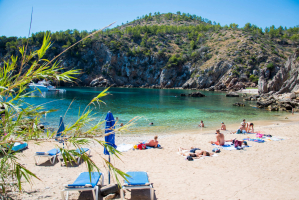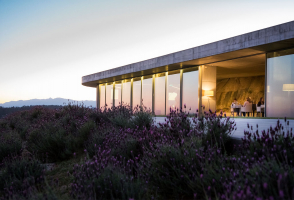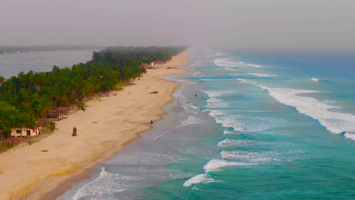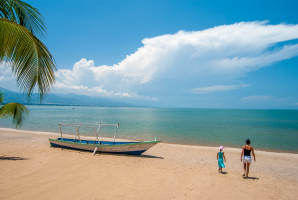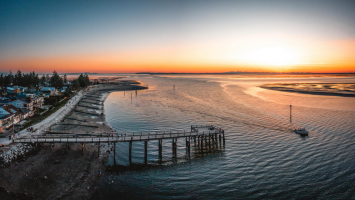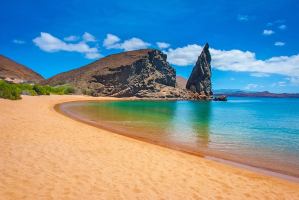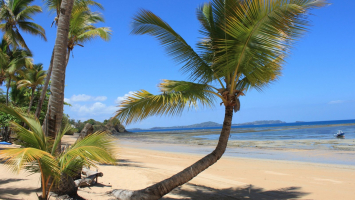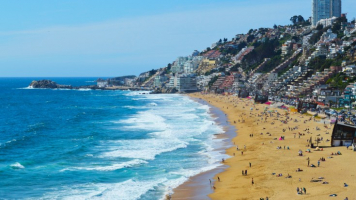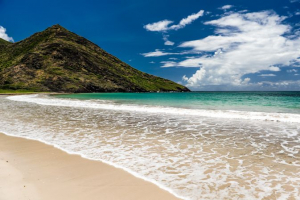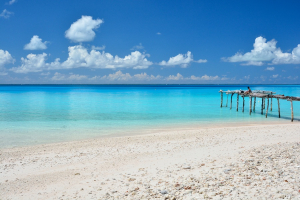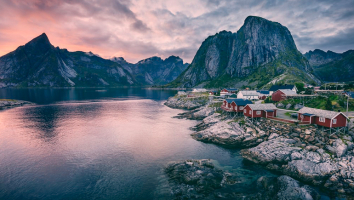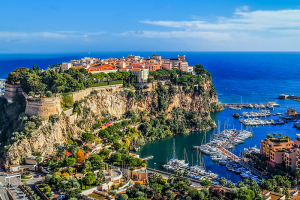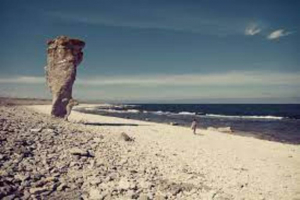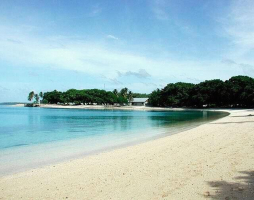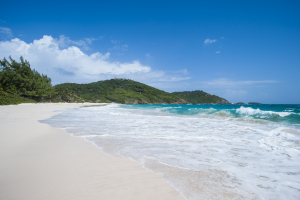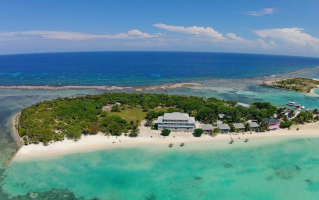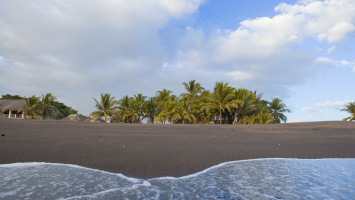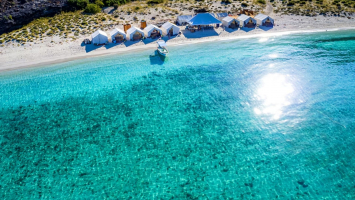Top 10 Best Beaches In Portugal
Portugal is blessed with 948 kilometers of Atlantic Ocean coastline. Much of the country enjoys a temperate Mediterranean climate, and it boasts some of the ... read more...finest beaches in Europe. Beaches dotted on the coast of central and northern Portugal also lure sunseekers, and many of the destinations here are wonderfully traditional in character and a great addition to a Portugal itinerary. Some have garnered a big-wave reputation. Pack your gear and pick a beautiful stretch of coast with list of the best beaches in Portugal.
-
Camilo Beach, near the busy seaside town of Lagos in the western Algarve, is one of the nicest beaches in southern Portugal. This beautiful area of sparkling white sand is accessible via a long wooden stairway that snakes down through a carpet of shrubby kermes oak and wrinkle-leaved rockrose, hemmed in by sandstone cliffs and strangely shaped rock formations.
It's simple to see why Praia do Camilo is so well-known for its breathtaking vistas! The beach is a little sandy beach with 200 wooden steps leading down to it, so make sure you're ready to climb back up after you've gone down! The beach is close south of Meia Praia, about a 25-minute walk or less than a 10-minute drive from Lagos. To find directions, click the link to the right. A restaurant with magnificent panoramic views is located on the cliffs above the beach. Praia do Camilo is a great place to go swimming because of its crystal blue waters. The bay is protected from the prevailing winds, making it a great place for kids to play. The sandstone rock formations along this length of beautiful shoreline are some of the greatest. As a result, this spot is ideal for capturing those perfect Instagram holiday photos.
For the more daring vacationers, the beach can also be visited via stand up paddle boarding, canoeing, or taking a boat ride. A lot of local activities, such as Sealife dolphin viewing Lagos, are also available nearby.
Location: Lagos, Portugal

Photo: visitportugal.com 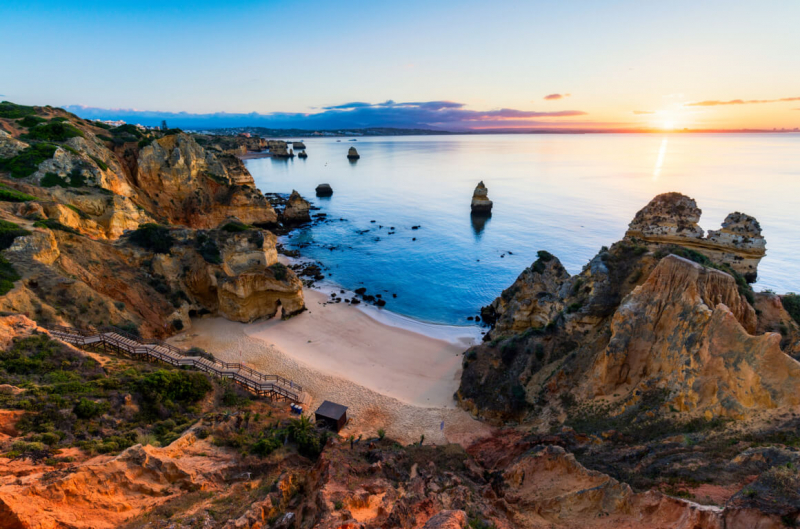
Photo: algarvetips.com -
Falésia Beach is one of the most famous tourist destinations in the Algarve, with a golden ribbon of sand stretching over six kilometers. The beach is part of a nearly 6-kilometer-long strip of sand. It is surrounded on one side by a line of towering cliffs in strong tones ranging from red to white, in stark contrast to the green of the pine woods above. The cliff is high but soft towards the western end, made of sand and clay, so rain wears away grooves and gullies. The cliff is steadily losing height to the east while being heavily degraded. This erosion is what maintains the beach sand-covered. As a result, little sand cones form at the base of the cliffs, where dune plants such sea daffodils, sea bindweed, prickly thrift, Cretan trefoil, and sea holly have established themselves. These plants coexist with the more uniformly colored vegetation seen on cliffs, which in this case is largely Mediterranean saltbush.
The overhang is crowned by a coastal promenade that winds through fragrant pine forests. Falésia is long enough that you may find a calm, uncrowded location to rest and tan even in the height of summer. A variety of top coastal resorts overlook the beach, including the premium PortoBay Falésia, which offers café and restaurant options to non-residents.Location: Praia da Falésia, Aldeia da Falésia, 8200-593 Albufeira, Portugal
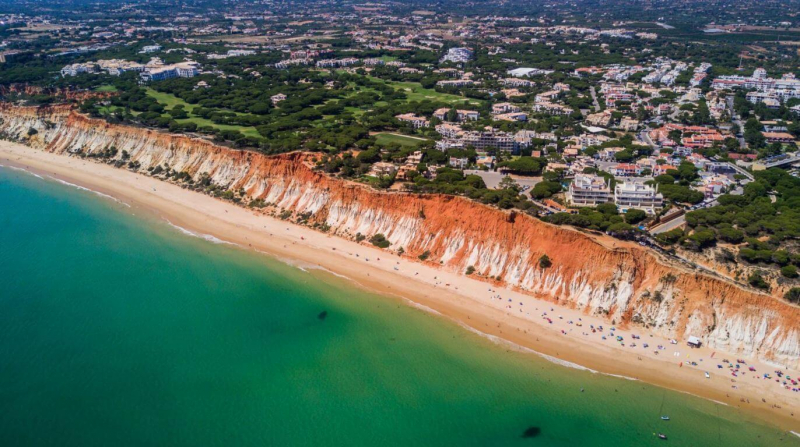
Photo: algarvetips.com 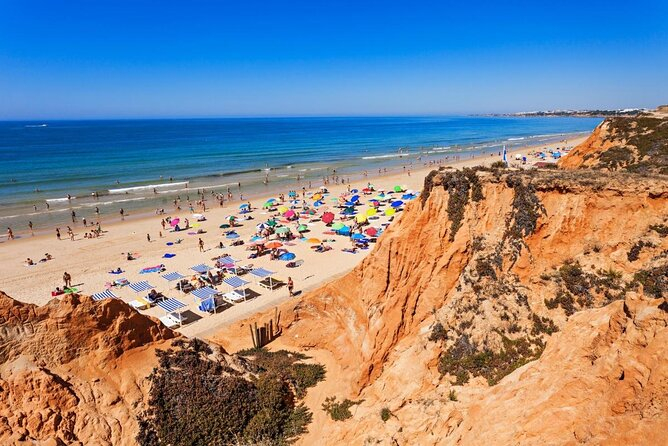
Photo: viator.com -
Amado Beach is a vast stretch of sand that stretches across three valleys. To the north, the cliffs' warm red and ochre hues dominate, while to the south, the grey of the jagged schist rocks takes center stage. Amado Beach is known for its diverse and adaptable waves, which warrant the establishment of on-site surfing schools. National and international contests in the sport are held there frequently.
Despite being a popular beach, if you wander along the sands for a while, you can locate some quiet corners. A network of walkways connects tourists to various portions of the beach as well as views from vantage points above it. There is a route that leads to Bordeira Beach via the cliff to the north, passing through Pontal and the strange fishing harbour of Zimbreirinha, where boats are anchored on wooden platforms dangling from the cliff. There are several rest stops along the way where you may take in the breathtaking beauty along this length of coast.
Amado Beach is one of the best surfing spots in Portugal. This lovely half-moon strip of sand is bordered by undulating dunes and falls inside the confines of the protected Parque Natural do Sudoeste Alentejano e Costa Vicentina, which is known for its consistent and diverse waves. Praia do Amado, like many of the beaches along the Algarve's wild and unpredictable Atlantic Ocean west coast, has multiple surf schools, some of which are open all year. Indeed, significant national and international surfing events are held in this location.
Amado is not for the usual resort-seeking traveler. It is remote and off the main path. Instead, this is a place for independent, free-spirited travelers who are fascinated by the region's varied flora and fauna.
Location: Costa Vicentina, Portugal
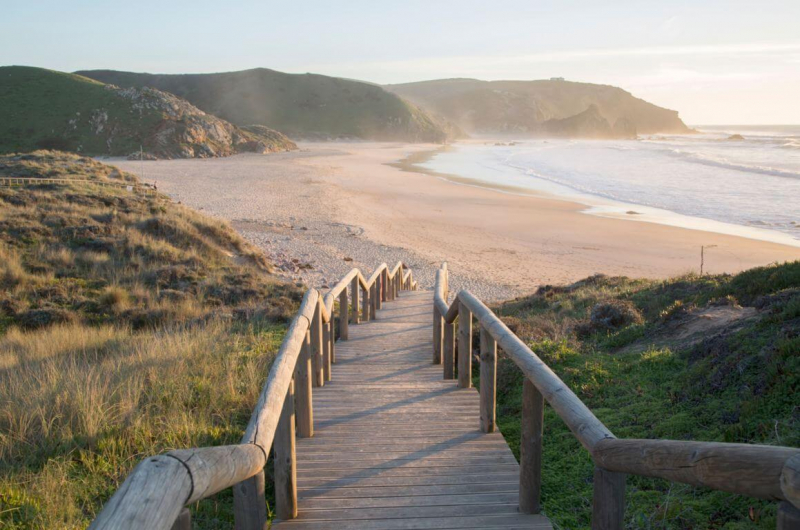
Photo: algarvetips.com 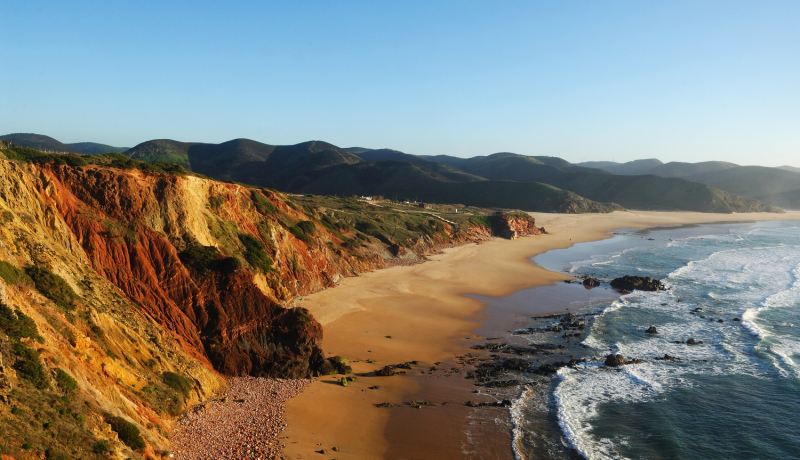
Photo:myguidealgarve.com -
Quinta do Lago has its own beach, which offers the same privacy, isolation, and exclusivity as the rest of the resort. The huge Ria Formosa Nature Reserve includes Praia Quinta do Lago, a magnificent, virtually white dune beach. It spans for about three kilometers across a biodiverse wetland and is only accessible through a long boardwalk.
Gigi's beach bar, which has been feeding beachgoers for almost 20 years, provides excellent service. Gigi's is located on an amazing stretch of sparkling white sand on the Ria Formosa's edge and offers some spectacular views. It's no surprise that it attracts some of Quinta do Lago's most famous guests, including Formula One racing drivers, pop singers, and even monarchy.
A diverse choice of water sports activities complements the extensive range of facilities available at Praia Quinta do Lago. The family-friendly beach boasts excellent windsurfing and kiteboarding conditions, and the waves are always suitable for novice surfers. Artur Watersports Academy is a 1500 square meter beach area where they offer equipment and instruction for a variety of motorized water sports. You can go water skiing or take a banana boat ride across the lake. Parasails, pedal boats, and stand up paddle boards are also available for rent and instruction.
Because the clientele at Praia Quinta do Lago is more exclusive than on other beaches, the costs are more. During the summer, a large number of families visit, making it highly crowded and busy. A short walk east or west will lead you to a remote place if you prefer a little more peace and quiet. Unfortunately, even there, you won't be able to escape the sound of jets taking off and landing.
Location: Quinta do Lago Off Roundabout 7, 8135-162 Almancil, Portugal
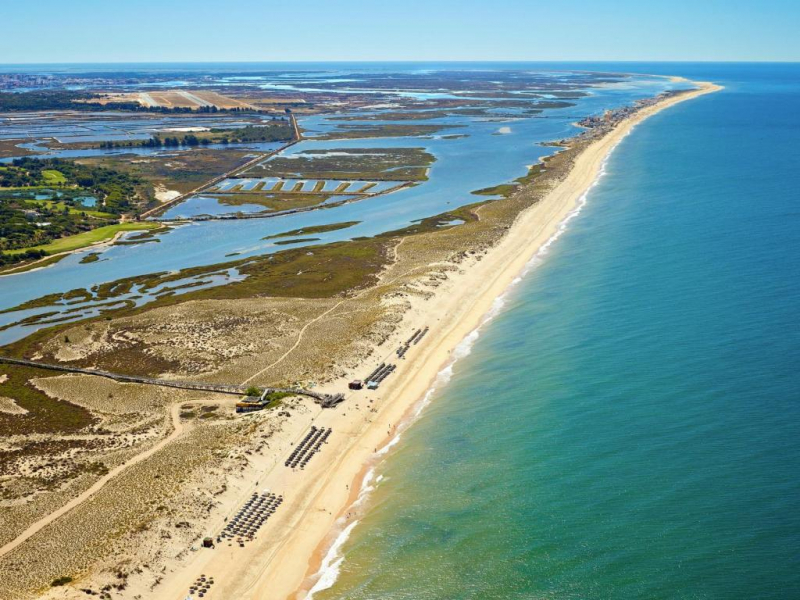
Photo: vietgiaitri.com 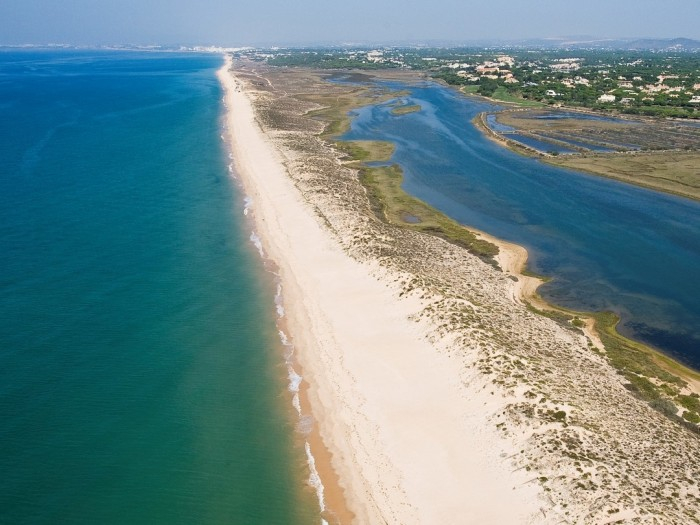
Photo: vietgiaitri.com -
The beach of Praia do Martinhal is located east of Sagres. It is one of the area's largest beaches. The little islets in front of Martinhal Beach make it easy to spot. These islets may be visited by boat, which is a fantastic experience. The wonderful soft and golden sand at Praia do Martinhal forms a natural bay with stunning limestone rock outcroppings. These islets, teeming with marine life, make for fantastic diving expeditions. Swimming is a safe activity, and there are numerous water sports to choose from. Windsurfing is possible when the wind is blowing from the north.
The beach faces east and is located in the somewhat sheltered Bay of Baleeira. As a result, the water on Martinhal beach is usually calmer than on other beaches that face the Atlantic Ocean directly. Even if the sea is quiet, there might be a significant amount of wind on the lake. As a result, you can participate in a variety of water activities here. The water starts off shallow and gradually deepens. Even in the height of summer, the water here can be extremely cold.Other activities include beachcombing the 30-minute walk west to Sagres and exploring the ruins of the Roman kilns located east of the resort complex.
Location: R. Baiona la Real Apartado 54, 8650-908 Sagres,Portugal
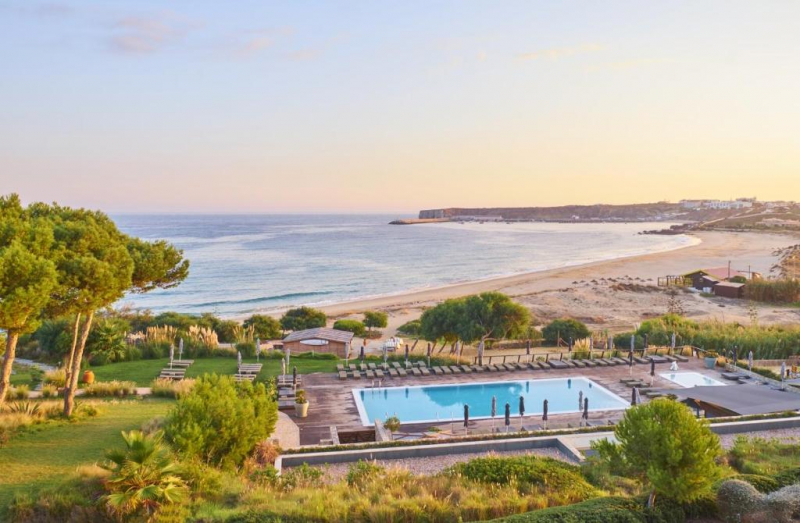
Photo: gites.fr 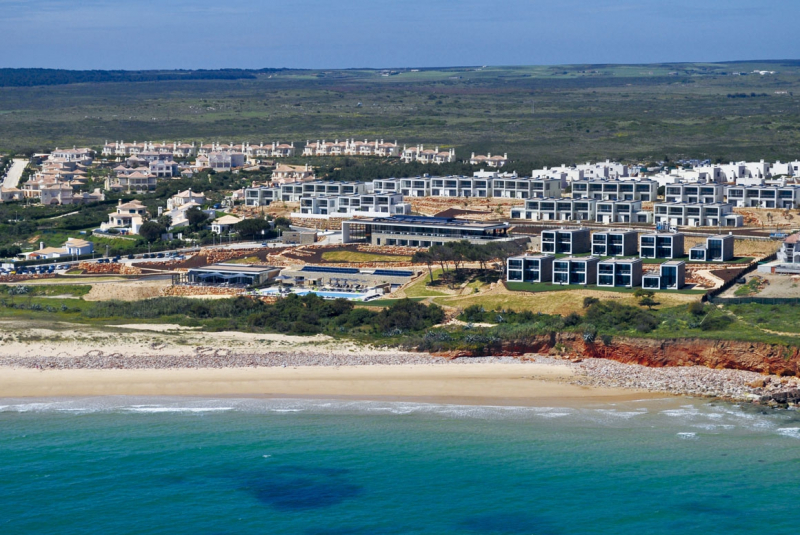
Photo: grupo-sanjose.com -
Praia do Guincho is a popular Atlantic beach on Portugal's Estoril coast, 5 kilometers from Cascais. It is part of the municipality of Cascais, namely the parishes of Cascais and Alcabideche, in the Lisbon District. Areia, Charneca, Figueira do Guincho, and Biscaia are just a few of the minor settlements near Guincho. The beach at Guincho, with the Fortess of Guincho in the background, as seen from the north.
The beach, which has an 800-meter beachfront, has ideal surfing conditions and is popular for surfing, windsurfing, and kitesurfing. During the summer months (June–August), strong northern winds and smaller north-west swells prevail, making this beach suitable for windsurfing and kitesurfing. The primary winds come from the east during the winter (particularly December), and swells grow in magnitude, making it an excellent site for surfing, with many beach-breaks offering powerful lefts and rights. In the vicinity, there are various surfcamps and surfschools that offer lodging as well as services like as rentals, repairs, and surfing lessons. Guincho, on the other hand, is located on the western boundary of the Sintra-Cascais Natural Park, which has safeguarded the beach from overdevelopment, as well as the fact that the waves and wind make it unsuitable for swimming and sunbathing, especially for families with little children.
Guincho isn't exactly a beach for tourists looking for a place to relax in the sun because it offers little protection from the elements. It's also not particularly family-oriented. Instead, for serious water sports aficionados, this is an adrenaline-pumping option.
Location: west coast of Portugal
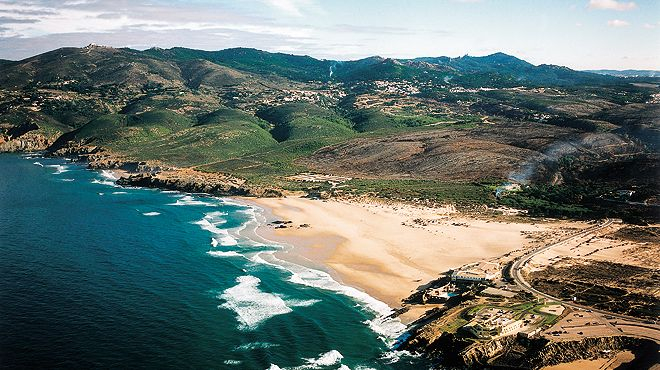
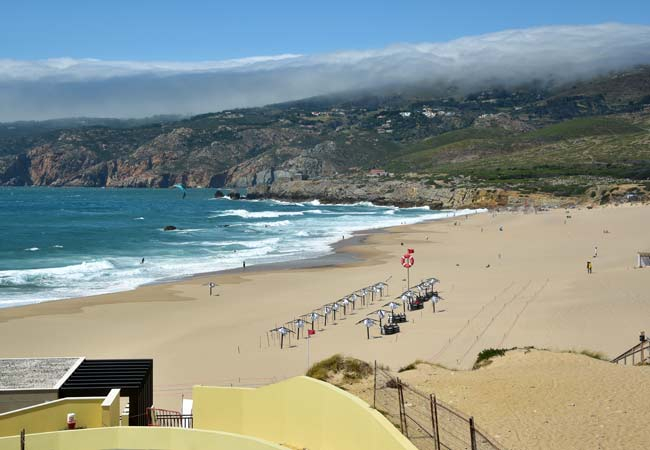
-
Praia da Rocha is one of Portugal's most well-known beaches, named after a resort near Portimo, the Algarve's second city. Rocha, a spectacular swath of sand with multiple boardwalks and pathways, is a popular summer vacation spot for both locals and tourists. The built-up area on the Atlantic Ocean in the southern half of the concelho of Portimo, Algarve, southern Portugal is known as Praia da Rocha. The Fort of Santa Catarina (Portimo) is located on the beach's western border. A castle built in the 17th century to protect the Arade River's mouth. Now a famous tourist destination, it can be reached immediately from the beach or from the road above. The seaside boulevard, a popular promenade packed with hotels, cafés, restaurants, and other recreational amenities, leads to the beach.
The nearby Portimo Marina and the Fortaleza de Santa Catarina fortification to the east of the beach, as well as the hilltop viewpoint at Três Castelos at the far western end, make for interesting viewing diversions. You can also see massive sandstone rock outcroppings here (rocha means "rock" in Portuguese). For a light lunch, pop along to the historic Bela Vista Hotel & Spa, built in 1918 and one of the first hotels in the region.Location: Portimão, Algarve, southern Portugal
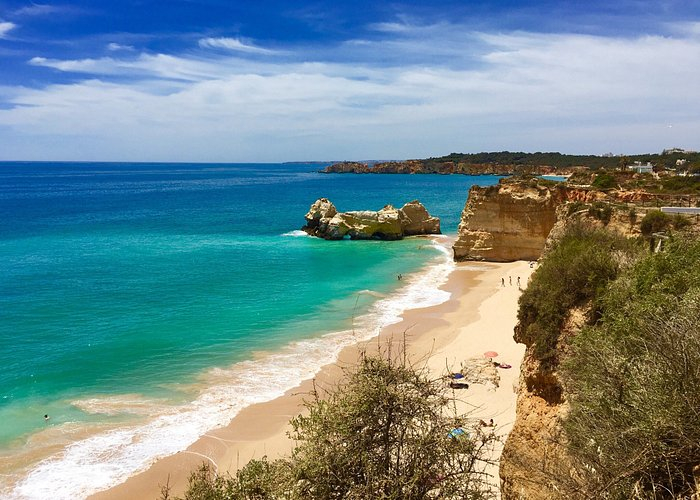
Photo: tripadvisor.com.vn 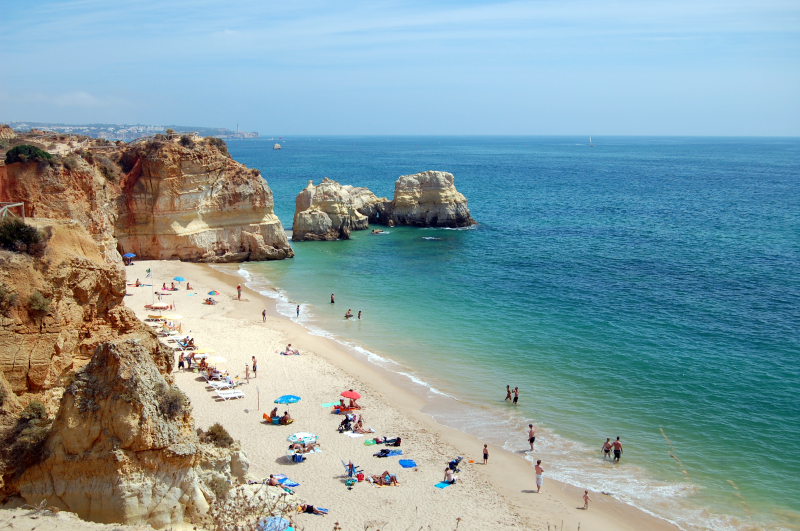
Photo: commons.wikimedia.org -
Nazaré is one of the Silver Coast's most popular seaside resorts (Costa de Prata). The fishing port of Nazaré, which has long been known for its traditional charm, is endowed with a wonderful beach that attracts sun worshippers to this lively town in central Portugal. With its warm climate and natural beauty, Nazaré Beach is home to one of Portugal's oldest fishing traditions. The town's sea front, which is also a long sandy half-moon shaped beach, is recognized for its grandeur and the vividly colored awnings that decorate the white sandy beaches, which contrast with the blue of the water.
This is the beach in Portugal where the more colorful fishing traditions are still alive and well, and it's not uncommon to see fishmongers dressed in the customary seven skirts. During the summer months, sit on the seawall at the end of the afternoon on Saturdays to see the spectacular "Arte Xávega" (Drag Nets) show, in which women yell out their items for sale as nets packed with fish arrive from the sea. Don't worry if you don't understand the language; they often utilize codes that only they comprehend.
Garrett McNamara, an American big-wave surfer who rode a monstrous 30-meter (100-foot) wave here and surfed straight into the record books, is one of the most well-known visitors. That was off the coast of Praia do Norte, over the Nazaré Canyon. The Nazaré Beach, a magnificent stretch of sand that hugs the town's wide, mosaic-patterned promenade, is preferred by most surfers and tourists. Sunbathers coexist with fishermen on Praia da Nazaré, who can be seen mending nets or drying mackerel and sardines on wire racks. The charm of the past is palpable. Meanwhile, there are numerous authentic seafood restaurants along the esplanade, as well as shopping and tourist opportunities.Location: Nazaré, Portugal
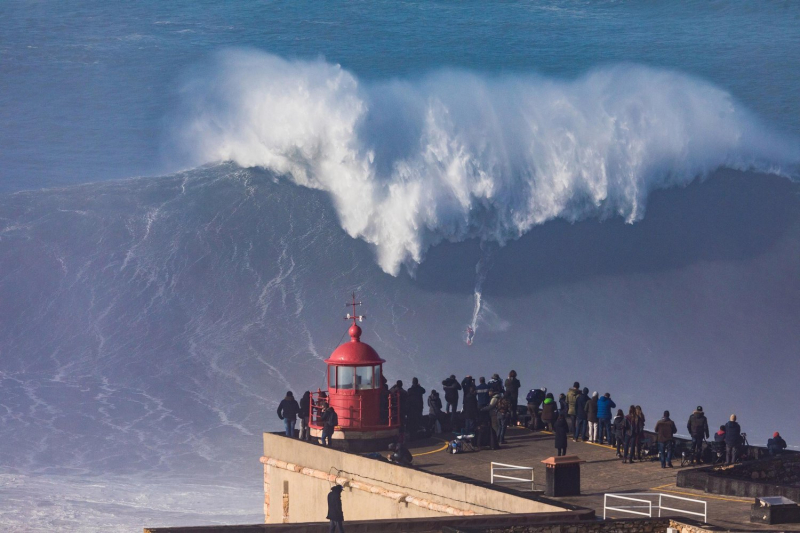
Photo: sworld.co.uk 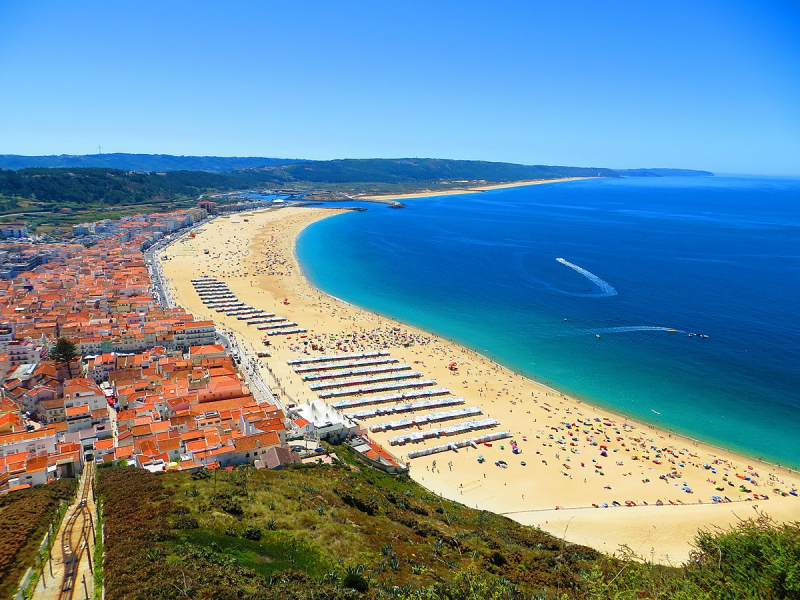
Photo: commons.wikimedia.org -
Comporta Beach, an hour's drive south of Lisbon, has a charming beach-shack ambiance. This simple hideaway, perched on the Tróia Peninsula – a sliver of sand jutting out from Portugal's Alentejo province's northern shore – is delightfully devoid of mass tourists.
The ocean conditions at Praia do Comporta are ideal for kite surfing. The beach, which is near to Comporta village, is bustling and a fantastic location for the thrilling water activity of kite surfing, whether you want to try it yourself or simply watch riders glide over the air and sea. The beach that bears the region's name is also one of its most popular. The beach is a vast stretch of white sand with colorful umbrellas strewn about. It attracts a large number of beachgoers due to its simple access and enough parking.
The pristine Praia da Comporta is the preserve of a chic, more discerning crowd, as well as in-the-know surfers, and is named after the charming little whitewashed village of Comporta, a gem of a place straddled over rice paddies and salt pans and where every chimneystack, it seems, has been commandeered by white storks. The bleached-wood eateries that punctuate the boardwalks surprise with their colorful and eccentric interiors, while thatched cabanas cling to shifting sand dunes.
Location: south of the Troia peninsula
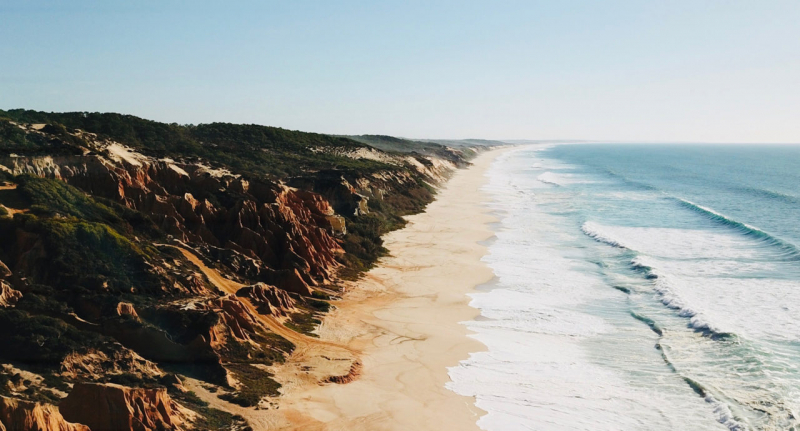
Photo: alma-da-comporta.com 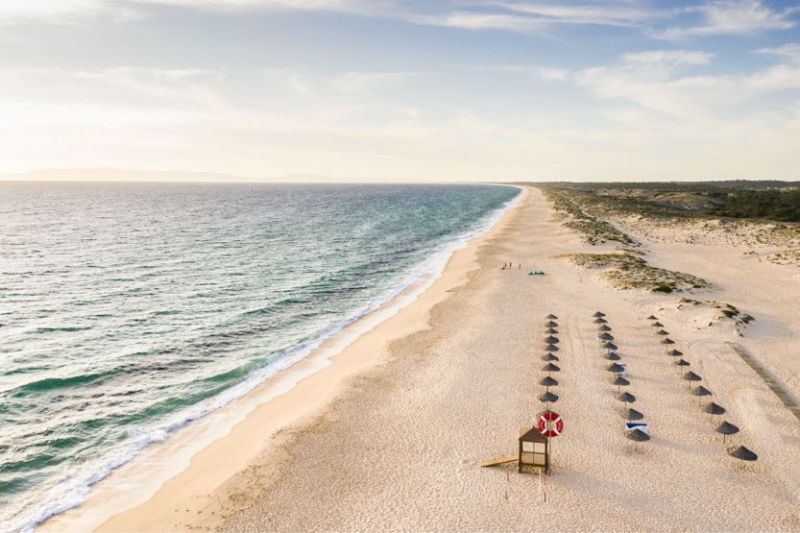
Photo: magazine.lecollectionist.com -
Carcavelos Beach is a popular day trip for locals and city-break travelers, located just 20 minutes west of central Lisbon by train. The beach is known for its exceptional leisure and water sports opportunities, particularly surfing, with a nearly two-kilometer beachfront of immaculate sand.
Surfers and bodyboarders flock to the area because of the high waves and surf schools, and volleyball and beach soccer players appreciate the almost 1km of sand, which is lined with nets. Even in the winter, the promenade attracts skaters and joggers, and there are pull-up bars and other workout equipment. There are wicker parasols for rent and massage services available from May to September. Many of the popular restaurants and bars that have outdoor seating are open all year. This is where many people gather on New Year's Day for the first dive of the year.
This isn't the most tranquil beach on the Lisbon coast, but its size, amenities, and accessibility make it a popular tourist attraction. It now competes with Praia do Conceiço in Cascais as the most popular tourist destination, thanks in part to its surf schools (where equipment can be rented). It is overseen by lifeguards throughout the spring-summer bathing season, and the swimming and surfing zones are divided. The 16th-century Forte de So Julio da Barra, an enormous military bastion still in operation and located at the eastern end of Praia de Carcavelos, provides a historical setting.
The esplanade provides a beautiful vista and is a great place to wander at any time of year. The beach is busiest throughout the summer, especially on weekends and holidays, when young people, families, and visitors flock here to escape the city heat.
Location: Lisbon, Portugal
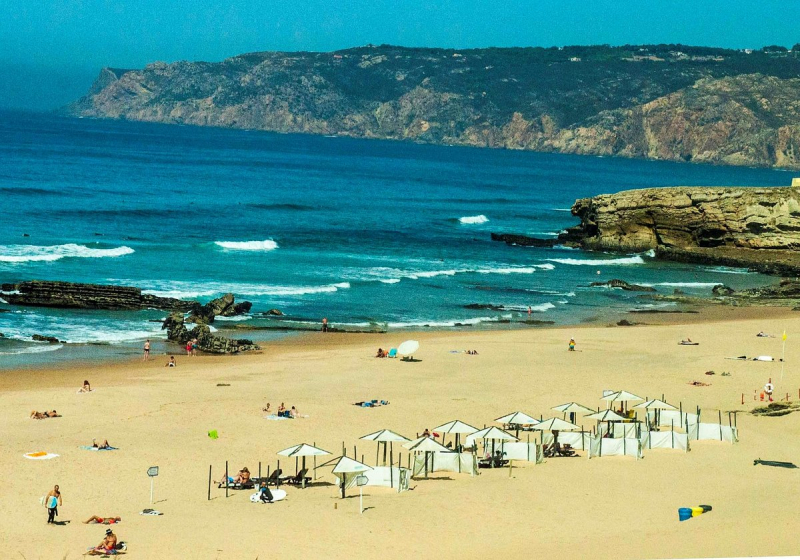
Photo: tripadvisor.com.ph 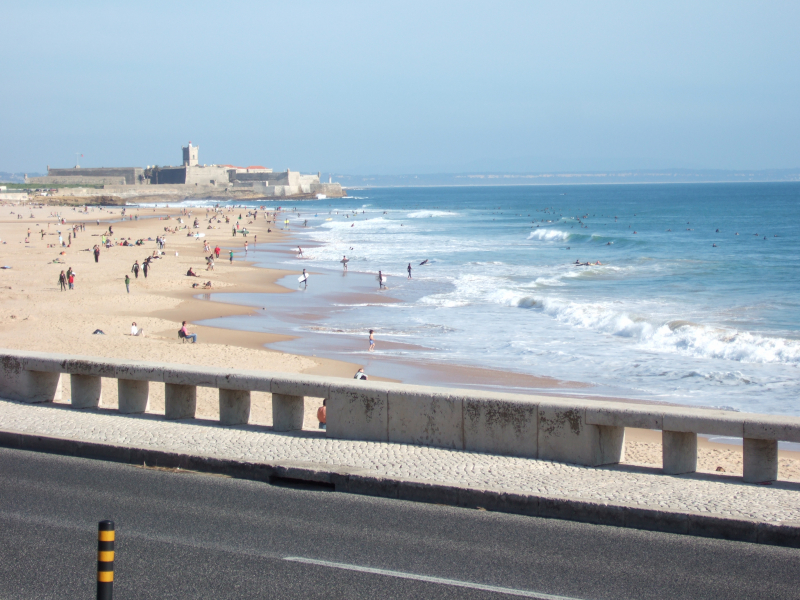
Photo: en.m.wikipedia.org












